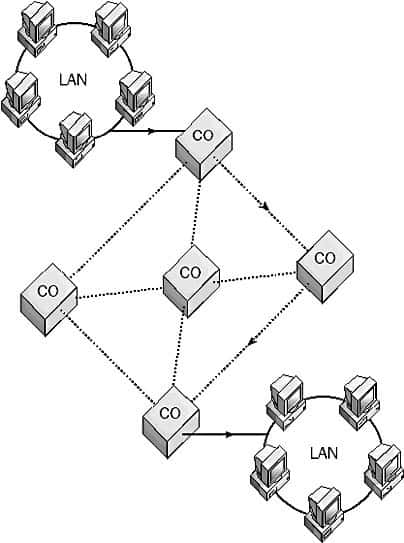Circuit Switched Services is a telecommunications service provided to businesses by telcos and long-distance carriers. «Circuit-switched services» is an umbrella term describing any service that provides switched connections between a consumer and a provider. The telephone system is an example of a circuit-switched service.
Circuit-switched services are temporary circuits only, and can be compared with leased lines, which use dedicated switches.
How it works
With circuit-switched services, a new switched circuit must be established each time one local area network (LAN) attempts to connect to a remote LAN. Different switches can be used for each attempt, depending on availability and traffic, so the quality of services can vary between connections. Your LAN is connected through bridges, routers, modems, and terminal adapters to the telco’s central office (CO), which sets up switches on demand to connect you to your destination LAN. When you disconnect the wide-area network (WAN) link, the switches are freed up for other purposes.

One advantage of circuit-switched services is that they are generally less expensive than leased lines. This is because switches are not dedicated to your network like leased lines are, and can, therefore, be used for other purposes when you are not using them. The cost for circuit-switched services is usually based on usage.
Another advantage of circuit-switched services is that you are not restricted to a single destination as you are with leased lines; you can dial up any destination that supports services similar to yours. However, dial-up or connection times vary with the technology used.
For example, analog modems might take 10 to 20 seconds to establish a connection, while an Integrated Services Digital Network (ISDN) terminal adapter might take only 1 to 2 seconds. This latency interval tends to make circuit-switched lines unsuitable for dedicated services, such as those used for connecting company Web servers to the Internet.
Another disadvantage of circuit-switched services is that the quality can differ substantially between connections because each circuit is a temporary connection that can exist along different paths, switches, and communication devices.
Circuit-switched services as backup lines
Circuit-switched services are often used as backup lines for more expensive leased lines. For example, if your more expensive T1 line fails, you can switch to a dial-up ISDN line (if it comes from a different provider). You should monitor your network usage with circuit-switched services because when a certain usage level is reached, leased lines become economically preferable.